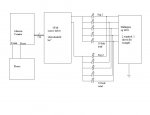Heya,
I've got my hands on some 100-seg led bargraphs.
they are split into 10 segments of 10 leds.
anodes address the segments, cathodes address the individual leds in that segment, if that makes sense.
my plan is to readadc, then output onto the bargraph
doing a common anode driver is easy, there are many off-the-shelf parts for this, and allows me to address the leds individually, as opposed to 1 at a time.
how do I do a common cathode driver tho? i can't find any off-the-shelf type parts that can drive 10 leds. I've thought about a johnson decade counter, as it only needs to address 1 segment at a time, and that only uses 2 pins, and works really well for a fast loop. but after that, how do i make a constant current driver? is there a dip18 style thing (like a darlington array?) that would do this?
I've got my hands on some 100-seg led bargraphs.
they are split into 10 segments of 10 leds.
anodes address the segments, cathodes address the individual leds in that segment, if that makes sense.
my plan is to readadc, then output onto the bargraph
doing a common anode driver is easy, there are many off-the-shelf parts for this, and allows me to address the leds individually, as opposed to 1 at a time.
how do I do a common cathode driver tho? i can't find any off-the-shelf type parts that can drive 10 leds. I've thought about a johnson decade counter, as it only needs to address 1 segment at a time, and that only uses 2 pins, and works really well for a fast loop. but after that, how do i make a constant current driver? is there a dip18 style thing (like a darlington array?) that would do this?

